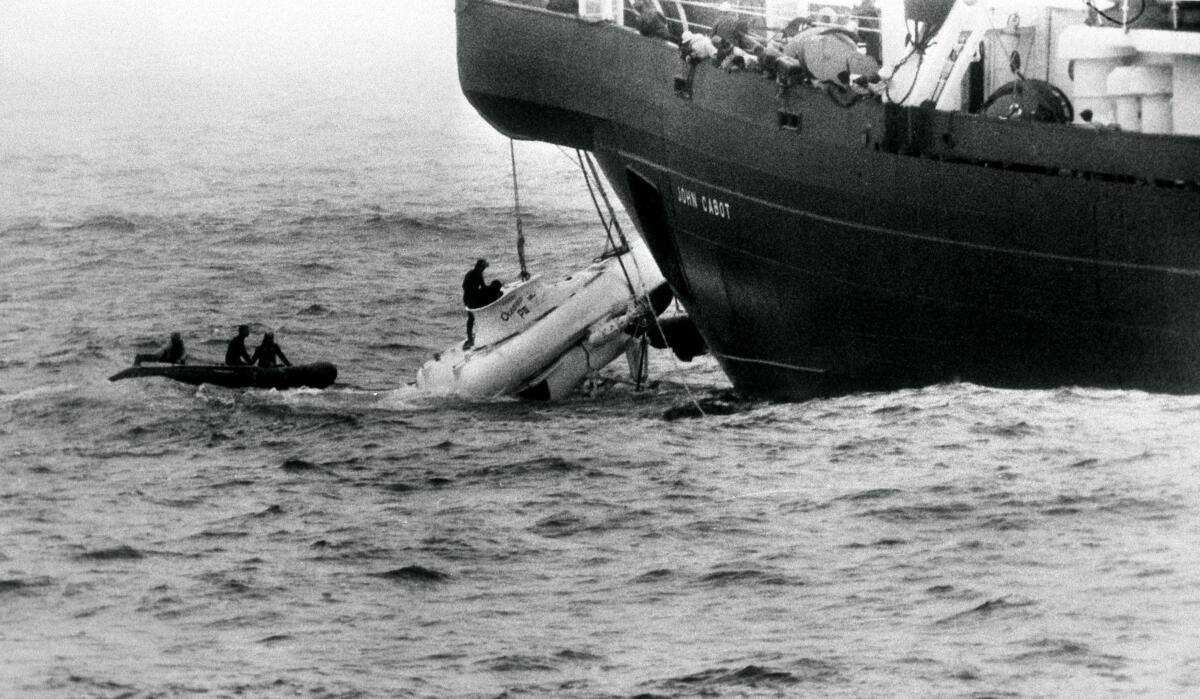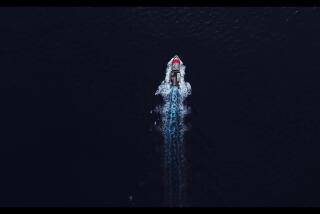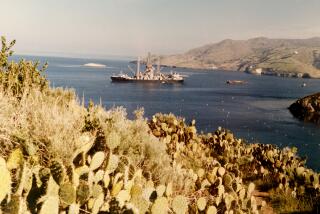New book recounts San Diego role in rescuing sub crew trapped 1,575 feet under the sea

- Share via
SAN DIEGO — Larry Brady was sleeping when the phone rang. “Sub lost,” his boss said.
Brady needed no further explanation. He got dressed and headed to work, to a Navy lab on Point Loma, where he was a key member of a team uniquely qualified to handle deep-sea disasters.
It was Aug. 29, 1973. Earlier that day, a tiny two-person sub laying telephone cable 150 miles off the coast of Ireland wound up stuck on the floor of the Atlantic Ocean. An accident on the surface had ripped off one of the hatches and flooded the vessel’s aft section.
The Pisces III was 1,575 feet down, too deep for divers to reach with a towing rope. They would need another sub to go down there, and fast. The two men in Pisces III, Roger Mallinson and Roger Chapman, had maybe 72 hours of oxygen left.
Calls for help went out to another Pisces working in the North Sea, and to one in Canada. The U.S. Navy was notified, too, which is why Brady’s phone was ringing.
He was the principal pilot of CURV-III, a remote-controlled submersible designed at the Naval Undersea Center to retrieve practice torpedoes and other lost ordnance. An earlier model made international headlines in 1966 when it found a hydrogen bomb off the coast of Spain that had been dropped by a B-52 after a midair collision with a refueling tanker.
Now the submersible and its seven-person crew were headed by cargo plane to Cork, Ireland, and into the middle of a drama that would have almost as many ups and downs as the high seas — equipment malfunctions and MacGyverish fixes, bruised egos and selfless sacrifices, terror and ultimately triumph.
It was a three-day cliffhanger that riveted the world, with news crews hiring fishing boats and helicopters to reach the site so they could send back regular updates.
Now the story has mostly faded from the public’s memory, replaced by more recent tales of the harrowing troubles humans find themselves in.
It hasn’t faded in the Bonita home where 85-year-old Larry Brady lives, though. “I remember,” he said, “every agonizing detail.”
A new book
The story of the Pisces III is getting a fresh look in a new 369-page book, “The Dive: The Untold Story of the World’s Deepest Submarine Rescue,” set to be published by Pegasus Books in early June.
British author Stephen McGinty was less than a year old when the accident happened, too young to have any memory of it. But he grew up fascinated by the ocean, and eventually he heard about the mishap and the scramble to save the lives of the two submariners — heard about it, appropriately enough, while he was at sea on a cruise.
Then he came across an old newspaper story from 1973 about the Pisces and grew more intrigued.
“It was the whole 3½-day ordeal of the men, what they did and how they survived, and also the brotherhood of the sea,” McGinty said in a phone interview from his home in Scotland. “I was very moved by the idea that when there’s a disaster, they put everything else on hold and try to go there to help. There’s this sense of duty to offer aid.”
McGinty is a journalist for the Sunday Times in London, as well as a producer of documentaries. His account of the Pisces unfolds with cinematic flair, cutting back and forth between the cold, tiny sub as the oxygen dwindled and the carbon dioxide rose, and topside, as the crews cobbled together frantic rescue plans for attaching a rope to the submarine and towing it to the surface. Movie rights have been optioned to the producer behind “Saving Private Ryan” and “Speed.”
McGinty said his research eventually pointed him toward Point Loma and its array of Navy bases and civilian contractors working on various maritime projects. “If there’s a still calm center of the universe for submarines in 1973,” he writes in the book, “it’s San Diego.”
CURV-III was the latest in a string of remote-controlled submersibles dating back to the 1950s. It was 13 feet long, five feet wide and seven feet high. It weighed 5,000 pounds and was operated via a cable connected to a control panel inside a small trailer on a support ship.
Brady sat at the control panel and used joysticks to manipulate the submersible’s steering, lights, cameras, and an arm that could grab and hold.
He loved the work, and was good at it. His career eventually spanned some 40 years, taking him around the world to recover helicopters, planes and more. He was confident CURV-III could help the Pisces III, too.
When his crew arrived in Ireland, though, it became clear the managers of the British company responsible for the stranded sub considered the Yanks to be back-ups. They would be used only if the manned subs brought in from Canada and the North Sea were unsuccessful.
“It was 1973, and Britain was in decline,” McGinty said. “There was this feeling that if the Americans were the ones who rescued them, it would be a real slap in the face.”
Setbacks, then success
The first rescue sub was sent down but started to leak and had to resurface. The second sub couldn’t find the Pisces III, which was resting on its tail in a canyon, making it hard to ping with sonar.
On the third try, the Pisces was found, but after the rescuers attached a tow hook, it slipped off.
Brady and CURV-III prepared to launch. The crew plugged in the control cable, and there was an explosion of electricity. Water had gotten into the system, and now the cable was a melted mess at one end. They would have to jerry-rig a repair.
And so it went, for hours and hours. Everyone was exhausted and on edge. In the Pisces down below, Mallinson and Chapman struggled not to use up all the oxygen and not to give up hope.
Eventually one of the manned subs attached a tow rope, but it was not considered strong enough to pull the Pisces to the surface. Brady sent CURV-III down and secured a second one with a toggle bolt.
“It almost felt anticlimactic after all the travel, loss of sleep and anxious moments,” Brady says in McGinty’s book, “but the insertion was really no harder than parking the car in the garage after a long drive home.”
The recovery made front-page headlines in newspapers around the world. Mallinson and Chapman became lifelong friends, talking on the phone every Sept. 1 to celebrate the anniversary of their rescue. By Chapman’s estimate, less than 20 minutes of oxygen remained when they made it to the surface.
Brady never got to meet the men, “a bit of a bitter pill to swallow,” he said. He and the submersible crew were taken back to Cork, where Brady bought a bottle of Irish whiskey to celebrate.
When they returned to San Diego, they were greeted as heroes. The city issued a proclamation declaring it “CURV-III Day.”
“We knew in our hearts what we’d done,” Brady said, “and we’d done good, and we were happy.”
More to Read
Sign up for Essential California
The most important California stories and recommendations in your inbox every morning.
You may occasionally receive promotional content from the Los Angeles Times.











